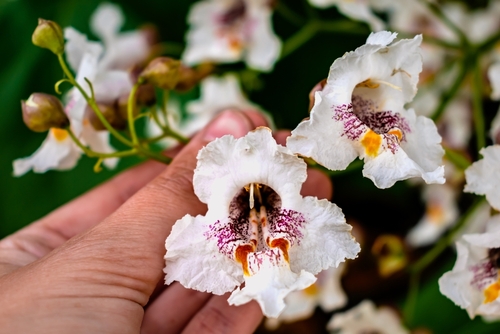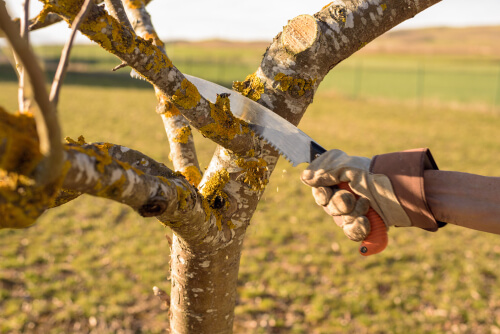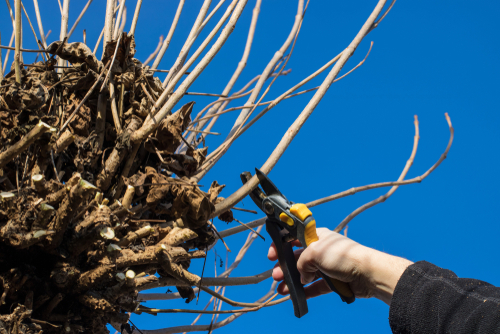Log in or create new account to save this product to your wishlist.

Pruning Catalpa Trees: A Guide to When, Why, and How
Master the art of catalpa pruning with our comprehensive guide. Learn to enhance your tree's beauty and maintain its ornamental features effectively.
🌱 All important maintenance moments for your lawn during the year. Leave your email and we will send you the lawn calendar for free.
Enter your email
Receive the lawn calendar in the mail
Enjoy a green lawn all year round!

- Order by 2PM = shipped today
- 250.000+ satisfied customers!
- 60 day satisfaction guarantee
Pruning catalpa trees is the best way to maintain the instantly recognisable shape of this enchanting plant. Also known as the cigar tree, the umbrella catalpa tree, or the Indian bean tree, the catalpa tree is a beloved plant for many homeowners and gardeners.
- What is a catalpa tree?
- Identifying the catalpa tree
- The beauty of catalpa blooms
- Ideal growth conditions for catalpas
- Pruning catalpa: when and why?
- How to prune a catalpa tree
- Catalpa tree care: watering, temperature, and fertiliser
- Dealing with catalpa tree problems
- FAQs
This article delves into the detailed process of pruning a catalpa tree, its care, and how to keep a catalpa tree small.
Read on to learn more about the beautiful catalpa bignonioides and how to care for it.
What is a catalpa tree?

The catalpa tree makes a magnificent addition to any garden. Belonging to the Bignoniaceae family, this deciduous tree is admired for its captivating blooming and unique shade foliage.
It can reach around 8-10m and prefers full sun exposure.
The catalpa tree is renowned for its resilience, which allows it to adapt well to different weather conditions and soil types.
Identifying the catalpa tree
As a small tree, catalpa has a sweeping growth characteristic with an umbrella-like shape.
The tree’s typically white flowers bloom from June to July and are characteristically shaped like bells arranged in panicles.
The leaves of the catalpa tree are heart-shaped and green.
The catalpa tree: position and soil
This hardy tree prefers a sunny to scattered light environment but is generally OK with a range of climates, making it ideal for the UK.
Additionally, the catalpa tolerates both acidic and alkaline soil and handles drought well, which is more likely in sandy soil.
If you’re unsure of your soil type, check out our article about improving your garden earth.
The beauty of catalpa blooms

Catalpa trees are widely appreciated for their abundant and spectacular flowers that appear in June, resembling orchids or irises, adding an exotic touch to the garden.
The blown blooms transform into long seed pods that dangle from the branches, like string beans on a vine.
These bean-like pods led to the tree’s name ‘Catalpa’, which is a type of bean plant in the Cherokee language.
Ideal growth conditions for catalpas
Catalpa trees are fast growers, making them ideal if you plan to establish a shaded area in your garden within a few years.
These trees love sunlight, making them excellent shade trees tolerant of most soil types, from sandy to clay and acidic to alkaline.
However, your catalpa will only really thrive in well-drained soil. They will survive flooding, but for best results, add sand or well-rotted compost to clay soils before planting to improve the drainage.
Plant your tree in the autumn to encourage root growth before the winter frost.
Pruning catalpa: when and why?

While the catalpa tree can thrive without pruning, occasional maintenance can help keep it in the best shape. Pruning is especially beneficial for young trees, ensuring stable growth and good shape as they mature.
Prune your catalpa after it has dropped its leaves or at the end of winter, when the plant is dormant, but the freezing temperatures have subsided.
Pruning catalpa is essential for several reasons:
- To remove the lower branches that might touch the ground.
- To eradicate dead branches or those twisting towards the inside of the tree.
- To ensure the tree has ample growth potential.
And remember:
Cut at an angle just above and facing away from the bud.
How to “pollard” your catalpa
Catapas respond positively to hard pruning, so never be afraid to remove the larger branches if you need to reshape the foliage.
Pollarding is cutting off the top branches to encourage fresh top growth, typically applied to young trees to help develop their shape.
Catalpas react well to this pruning method, restricting the tree’s height and making it more shrub-like.
However, wait until January to March to pollard your catalpa for best results.
How to prune a catalpa tree

Begin pruning your catalpa after its first year in the ground, trimming away any suckers from the base and cutting back the lower branches with a pruning saw, helping promote a straight, upright, central trunk.
Keep the lower branches trimmed as the catalpa matures, allowing for easier ongoing maintenance.
Try to maintain the tree’s natural shape, which should always be taller than it is wide.
Prune young trees regularly to promote a robust branching structure. And avoid shortening the main shoot and the side branches to prevent the risk of branches breaking.
Catalpa tree care: watering, temperature, and fertiliser
Catalpa trees are generally easy to care for, requiring little other than the water provided by the UK’s precipitous climate. However, it’s always a good idea to water well during the first few years while the tree establishes its roots.
You won’t need to fertilise if your soil is moist and rich. However, when planting in clay, silty, sandy, or dry soils, apply a 10-10-10 fertiliser a few weeks after planting to promote healthy growth.
Dealing with catalpa tree problems
Catalpa tree problems can occasionally arise, such as diseases like Verticillium wilt and powdery mildew, or pests, such as voles, can attack your tree’s roots.
However, the best approach to avoiding diseases is by keeping your catalpa tree healthy and strong. We recommend feeding your tree with nourishing fermented weed tea to protect it from fungal diseases and pests.
Another common issue that arises from the catalpa tree is the fallen seed pods at the end of the season, which become slippery on pavements, causing a potential slip hazard. So, avoid planting your catalpa near public pavements and footpaths.
FAQs
It’s fine to leave a catalpa tree to nature – it will grow happily without much intervention. However, an un-pruned catalpa will grow quickly and quite possibly crowd your garden. So, prune your catalpa to maintain its size and remove dead or diseased wood to keep it healthy.
These hardy trees live for up to 60 years and are both drought and flood-resistant. They grow in a range of soil types and aren’t particularly fussy about being fertilised. However, it’s always a good idea to feed your garden trees and plants once a year to keep them in tip-top condition. Catalpas grow quickly, so get pruning to maintain a smaller tree.
Catalpa trees are fast-growing and develop large root networks, so avoid planting them too close to your house, or there’s potential for the roots to damage your home’s foundations. You can protect buildings by burying deflectors around the tree’s roots to prevent them from overspreading.
Ready to go?
Pruning catalpa trees doesn’t have to be complicated. Indeed, regular care and attention can help prevent catalpa tree problems, ensuring that your tree remains a stunning feature in your garden.
So, whether you’re keeping a catalpa tree small or letting it grow to its full height, this tree is a truly majestic addition to any outdoor space.
And you can find out all about pruning other types of garden trees, such as apple, fig, beech, yew, and conifers.
Happy pruning!
-
Orchids: A Complete Guide on How to Care for ThemWant to give your orchid the best possible care? Discover essential tips from placement to watering and pruning. Learn everything you need to know!Read more
-
Growing Wisteria Made Simple: From Planting to Perfect BloomsWith blossoms like a purple waterfall, Wisteria sets an almost magical and colourful mood. If you want to grow this beauty in your garden, you’ll need a bit of patience. Don’t worry, it will most definitely pay off.Read more
-
How to Build a DIY Greenhouse: A Practical Guide for Smart SpendersImagine extending your growing season throughout the year, nurturing tender plants regardless of the weather, and creating a personal garden sanctuary. This is precisely what a DIY greenhouse offers you. Let’s learn how to build one.Read more
-
How to Grow Eucalyptus in British GardensWith a little love and care, eucalyptus trees can thrive in English gardens. Since they don’t germinate well without proper help, there are not considered invasive. So, there is no reason not to plant them if you enjoy their looks.Read more
-
Transform Your Garden with All-Year-Round Flowering PlantsDid you know you can enjoy blooming flowers even in January? With the right selection of all year round plants, there’s no need to wait until spring to add some colour to your garden.Read more
-
How to Create a Butterfly Garden: A Simple Guide for British GardensThe UK's butterfly population includes 59 different species. These beautiful winged creatures face a steady decline because of habitat loss, pollution and changing weather patterns. Your garden can become a vital link between nature reserves and natural habitats. Let’s explore how.Read more
-
Volcanic Rock Dust for Your Garden—Application and TipsDid you know that volcanic rock dust is a brilliant organic soil improver? This article explains exactly what it's good for and how to use it properly.Read more
-
How to Use Landscape Fabric ProperlyIf weeds or erosion in your garden are troubling you, landscape fabric might be the solution. We’ll explain how and when to use it properly, just keep on reading.Read more
Leave a comment
Your answer will be displayed on the site and the interested party will be notified by email.
Leave a comment
Have a question or want to share your experience? Leave us a comment.

- Order by 2PM = shipped today
- 250.000+ satisfied customers!
- 60 day satisfaction guarantee

- Order by 2PM = shipped today
- 250.000+ satisfied customers!
- 60 day satisfaction guarantee

🌱 All important maintenance moments for your lawn during the year. Leave your email and we will send you the lawn calendar for free.
Enter your email
Receive the lawn calendar in the mail
Enjoy a green lawn all year round!






















Comments (0)
There are no comments yet. Well then, what are you waiting for to
Be the first to write your comment!inaugurate this pretty page?
Do you have some comments?